IoT
Deep Learning in the IoT Industry
HOW EMBEDL'S MODEL OPTIMIZATION SDK IS REVOLUTIONIZING THE IoT INDUSTRY
In the fast-evolving world of the Internet of Things (IoT), the efficiency of model deployment is crucial. The Embedl Model Optimization SDK is a game-changer, designed to shrink models to fit the available memory size, enabling them to be executed on IoT devices seamlessly. This SDK not only optimizes models for memory efficiency but also minimizes inference time and power consumption, making it versatile for any type of target processor.
WHAT IS EMBEDL'S MODEL OPTIMIZATION SDK?
Trying to fit deep learning functionality to IoT devices is a challenge but can be required when there is a need to reduce bandwidth usage, protect privacy or make a decision on the device. The compute power in many IoT devices is provided by microcontrollers rather than SoCs and the available memory is usually measured in KB or MB rather than GB.
Embedl Model Optimization SDK is used to shrink models to fit the available memory size so that they can be executed on IoT devices. Models can also be optimized to minimize inference time or power consumption on the device and can be applied to any type of target processor.

FASTER EXECUTION
By using state-of-the-art methods for optimizing Deep Neural Networks, we can achieve a significant decrease in execution time and help you reach your real time requirements.


SHORTER
TIME-TO-MARKET

Less ENERGY USAGE
Energy is a scarce resource in embedded systems and our optimizer can achieve an order of magnitude reduction in energy consumption for the Deep Learning model execution.

IMPROVED
PRODUCT MARGINS
By optimizing the Deep Learning model, cheaper hardware can be sourced that still meets your system requirements leading to improved product margins.

DECREASED
PROJECT RISK
Optimizing and deploying our customers’ Deep Learning models to embedded systems is what we do. By outsourcing this to us, your team can then focus on your core problems.
Get in touch
Discover the limitless possibilities of Embedl and experience a whole new level of efficiency, affordability, and innovation in the field of deep learning.
